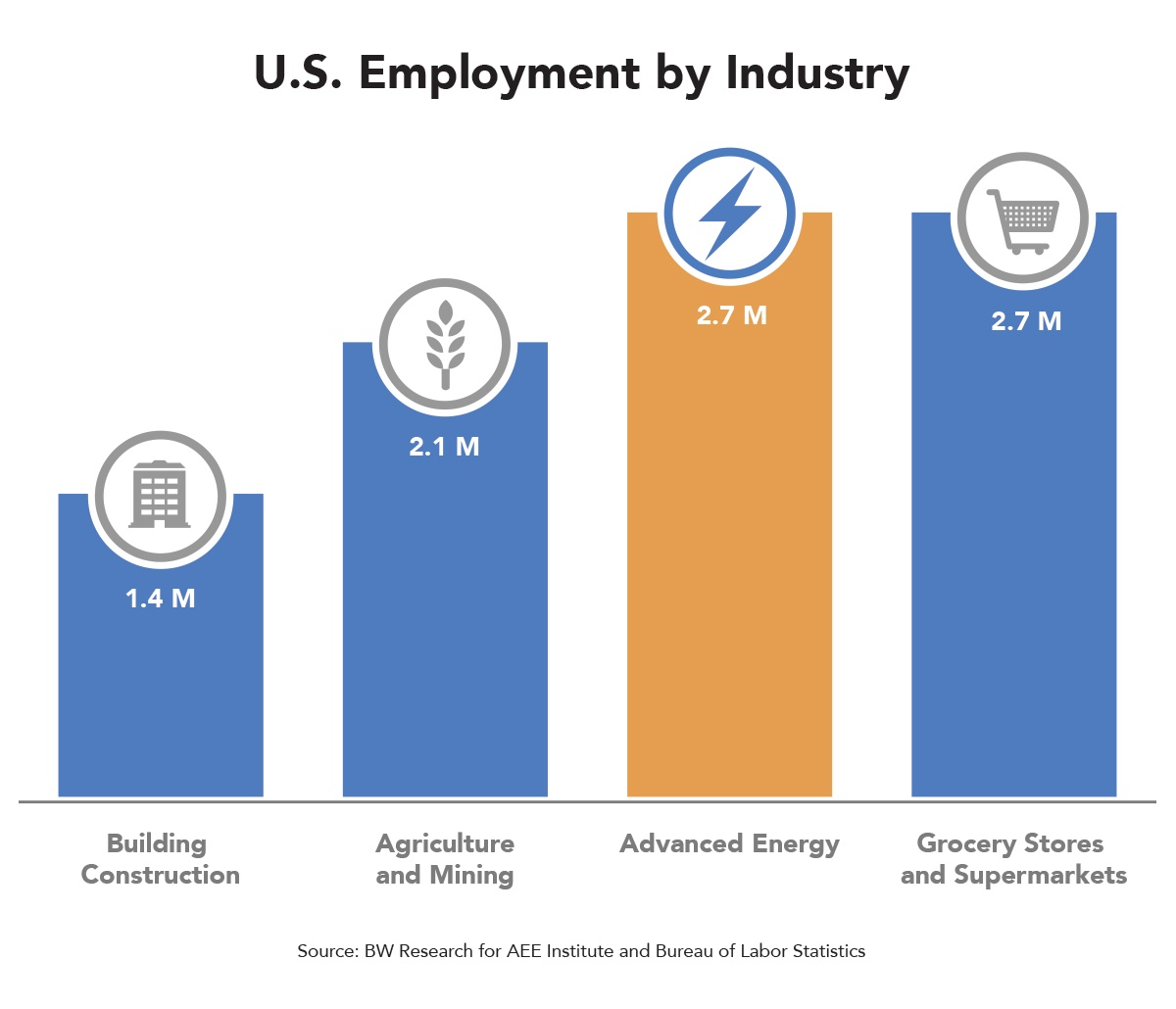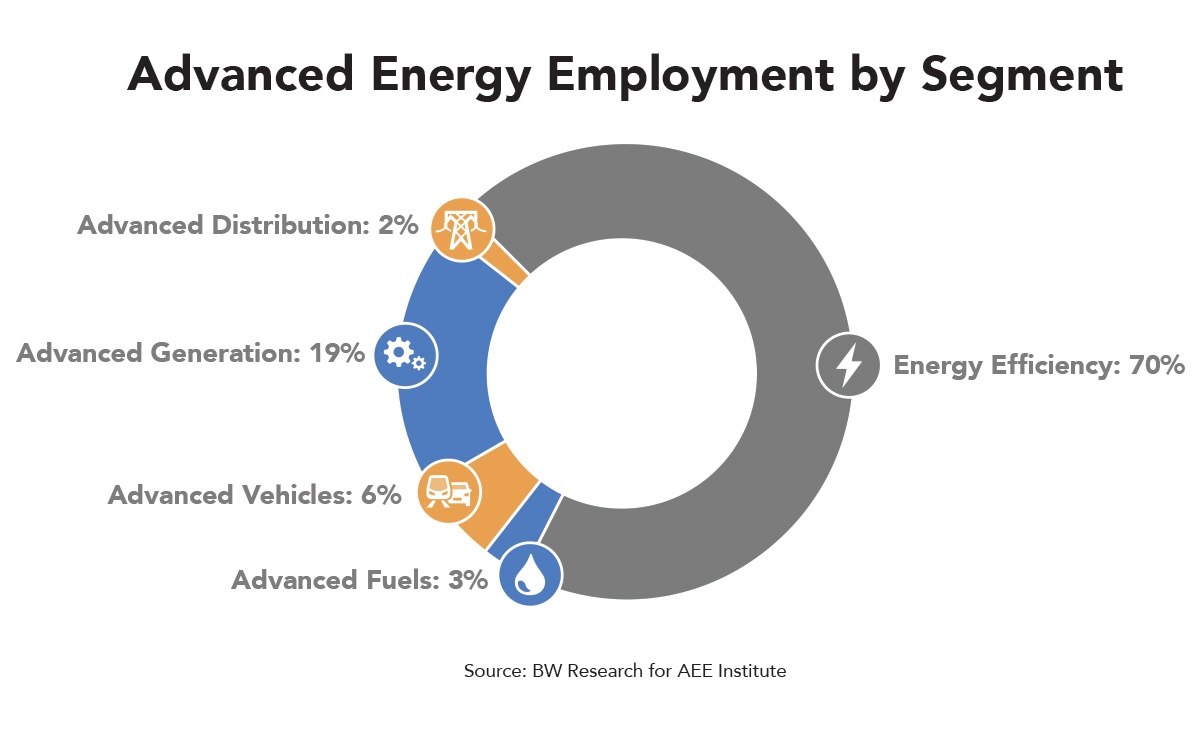
For years now, AEE has been tracking the growth of the advanced energy industry in terms of dollars. Since 2011, U.S. advanced energy revenue has grown 29%, reaching $200 billion in 2015. While market growth has been impressive, we have struggled to pinpoint the number of jobs supported by the industry given the complexity of industry surveys. But now, thanks to newly available data, we can say definitively that advanced energy is a major source of employment in the U.S. How does advanced energy measure up compared to other employment sectors? Let’s look at the numbers.
At 2.7 million workers, advanced energy supports nearly twice as many jobs as building construction, significantly more than agriculture and mining, and equal to supermarkets and grocery stores. Advanced energy jobs are growing, too: Employers report an increase of 10% from 2014, compared with overall U.S. employment growth of 2.5% last year. These companies also expect to add employees at a 6% rate over the next 12 months.
Jobs related to the advanced energy industry have not been quantified nationally until now. The new Energy Employment Index, produced by BW Research Partnership, is based on the most recent data from the Bureau of Labor Statistics and a detailed survey of over 20,000 businesses conducted between September and November of 2015. The Index is the basis for the U.S. Dept. of Energy’s first annual U.S. Energy and Employment Report, which was published in March.
Through arrangement with BW Research Partnership, AEE is able to draw on the Index, which covers employment in the entire energy industry, to quantify the jobs directly associated with advanced energy, nationally, as well as in selected individual states, as in the AEE Institute’s recent Advanced Energy Jobs in California report.
For our purposes, advanced energy employees are defined as full-time and part-time permanent employees of businesses that are engaged in advanced energy activity for all or a portion of their revenue, and who themselves support the advanced energy portion of these businesses. In other words, they are people who spend some or all of their time making or deploying advanced energy products and services. We are also able to determine what portion of these individuals’ work time is spent on advanced energy activities versus other aspects of their employers’ business.

The findings, first unveiled during AEE’s “State of Advanced Energy” webinar, are eye-popping: Of the 2.7 million advanced energy workers nationwide, 1.9 million are involved in energy efficiency – making buildings meet their needs with less energy through tighter building envelopes, better HVAC systems, more efficient equipment and appliances, and smarter energy management. While all of these employees are engaged in energy efficiency activities, not all of them do so as their primary work activity. Roughly one third of these employees work primarily on conventional HVAC equipment, although they also spend a portion of their time on high-efficiency systems. So there is plenty of room for greater advanced energy penetration in these building-related services, in order to make buildings higher performing.
In terms of magnitude, after energy efficiency come jobs in advanced electricity generation – approximately 533,000 nationwide. Nearly 300,000 of these jobs are in solar energy. (Note: The Solar Foundation also utilizes the BW Index for its employment data, but for its purposes counts as solar workers only those who spend more than half their time on solar, coming up with 208,000 solar jobs nationally.) The rest are spread across wind, hydro, geothermal, biomass, natural gas, waste energy, and nuclear power generation.
Other advanced energy employment sectors are smaller, but still substantial: over 46,000 in Advanced Grid technologies, which include smart grid, energy storage, and electric vehicle charging stations; 80,000 in Advanced Fuels, mainly biofuels and biomass; and nearly 170,000 in Advanced Transportation, which includes R&D, manufacturing, wholesale trade, and maintenance of hybrid and electric cars, natural gas trucks and buses, and fuel cell vehicles.
And who are these advanced energy workers? Currently, 75% of advanced energy employees nationally are men, compared with 53% of the U.S. civilian labor force as a whole. Racial and ethnic minorities make up 25% of advanced energy workers (versus 37% of the labor force). Veterans make up 10% of the advanced energy workforce, while employees who are age 55 and over represent 16% of the total.
An advanced energy economy is what AEE is working toward. That’s not just dollars and cents; it’s people, too – people at work, as well as people who, as customers, enjoy the comfort, convenience, and control of advanced energy at home and in the office. These numbers, which show advanced energy to be a major source of employment and job growth, help to fill out the picture of the advanced energy economy that is here now and on the rise.
For more information on the advanced energy industry's overall size and scope, view the webinar, linked below. The recorded webinar presents highlights from the fourth edition of AEE's annual report of market size, by revenue, of the advanced energy industry, both worldwide and in the United States.
